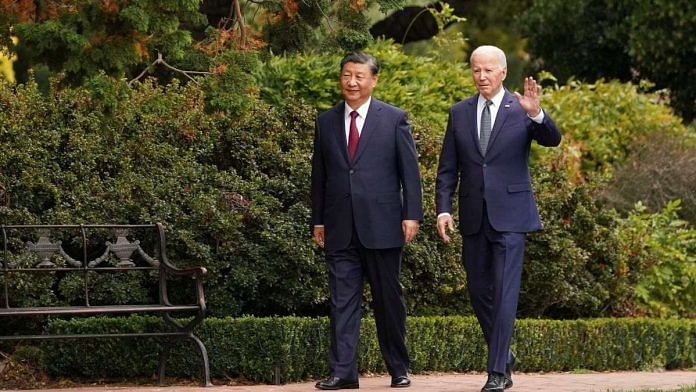Chinese President Xi Jinping and United States President Joe Biden finally had a face-to-face meeting in San Francisco on the sidelines of the Asia-Pacific Economic Partnership summit on 15 November. This marked Xi’s first visit to the US in six years and his second meeting with Biden since the latter assumed the presidency in 2020. The meeting seemed highly orchestrated. This was clearly highlighted by Biden’s compliments on Xi’s Hongqi N701 Limo, a gesture celebrated by the Chinese Ministry of Foreign Affairs on X and Chinese social media users on Weibo. The comparison between Biden’s Cadillac, known as the Beast, and Hongqi seemed to be regarded as an achievement of sorts. One of the top trends on Weibo was “Biden called ‘Made in China’ Hongqi beautiful”.
While the visit was heavy on optics and light on substance, both sides breathed a sigh of relief as Xi’s visit to the US and meeting with Biden concluded without any major hiccups. Expectations, however, remained low. Despite this, the visit was heralded as a success, considering the inherent unpredictability and volatility in the China-US relations, which have made the ties increasingly fragile. Even pre-planned visits have faltered as a result. A prime example was the cancellation of US Secretary of State Antony Blinken’s visit to China following the sighting of a Chinese spy balloon off the Carolina Coast in February earlier this year.
Where is China’s wolf-warrior diplomacy?
This year witnessed a deliberate departure from the aggressive ‘wolf-warrior diplomacy’ adopted by China during the Covid-19 pandemic. A significant signal of this change was the reassignment of Zhao Lijian, one of the main crusaders of the wolf-warrior diplomacy, to a less prominent role within the foreign affairs ministry in the Department of Boundary and Ocean Affairs. This shift appears to signal China’s willingness to stabilise ties with the US as it deals with the economic slowdown and rise in unemployment within the country.
The tone had been set well in advance. For example, a week before Xi’s US visit, Wang Wenbin, China’s MFA spokesperson said: “The two sides need to return to what was agreed between the two Presidents in Bali and truly act on it. What is vital is for both sides to rise above disruptions, overcome obstacles, expand common understandings and accumulate potential outcomes.” The series of visits by US officials to China, along with reciprocal engagements, notably contributed to a smooth visit without any major hitches. Perhaps, the only controversial moment emerged when Biden restated during a press conference that he still considers Xi a dictator. Nevertheless, it is notable that there was a clear shift in demeanour and tone from the Chinese side. Xi did not exhibit the same level of assertiveness as he had during the Bali G20 summit last year.
There appears to be an expectation in China that following this summit, the rhetoric from the US will be toned down. This sentiment was echoed in an editorial in Xinhua, suggesting that China and the US are meeting halfway for global economic recovery. Even the Chinese edition of the People’s Daily called “the Xi-Biden exchange as positive, comprehensive and constructive, and echoed that San Francisco should become a new starting point for stabilising Sino-US relations”.
Also read: Beijing is neutral on Israel-Palestine conflict. But Chinese people are saying something else
What’s the real deal?
Over the past year, especially following China’s cessation of military-to-military dialogue due to US House Speaker Nancy Pelosi’s visit to Taiwan in August 2022, the US has made concerted efforts to initiate high-level dialogue with China. A crucial element of the US’ China policy involves projecting an image of a responsible stakeholder and a perceived readiness to accommodate China in the Indo-Pacific region.
In assessing the outcome of the Xi-Biden summit, it appears that the US emerged with more tangible gains compared to China. While China effectively utilised its MFA and state-owned media to portray the summit as a victory, projecting an apparent improvement in China-US relations, the substantive gains seem to favour the United States—the most pivotal being the reinstatement of military-to-military communication.
However, the discourse on Chinese social media diverges from official posts and accounts on X. Most users express less optimism about the future of the relations. A prevalent view on Weibo suggests scepticism regarding substantial changes despite Xi’s perceived successful visit to the US. There is a belief that the US won’t readily accommodate China’s rising economic and military stature. Developments like the US tightening controls on technology transfer, emphasising the significance of cooperation within the Quad (which is widely perceived as an anti-China coalition), and security cooperation with and defence assistance to Taiwan align with the views on Weibo on the status of China’s relations with the US. This scepticism indicates that a complete reset in the China-US relations is unlikely.
A recurring pattern of conflicts, blame shifting, short-lived truces, and an inevitable return to conflict characterises the enduring reality shaping China-US relations within the larger context of the Indo-Pacific geopolitical landscape. It is apparent that a single meeting cannot drastically reshape the dynamics between China and the US. Fundamental disparities persist, particularly regarding critical issues like Taiwan and the South China Sea’s freedom of navigation.
While summits like these serve as temporary measures to manage relations and avert miscalculations, their capacity to forge a lasting resolution to the hostilities remains constrained, given the complex nature of the rivalry between China and the US. The China-US relations remain delicately balanced, hanging by a thread. Any single point of contention could potentially trigger a regression into a phase of entrenched hostilities.
Sana Hashmi, PhD, is a fellow at Taiwan-Asia Exchange Foundation and George H.W. Foundation for US-China Relations. She tweets @sanahashmi1. Views are personal.
(Edited by Prashant)



